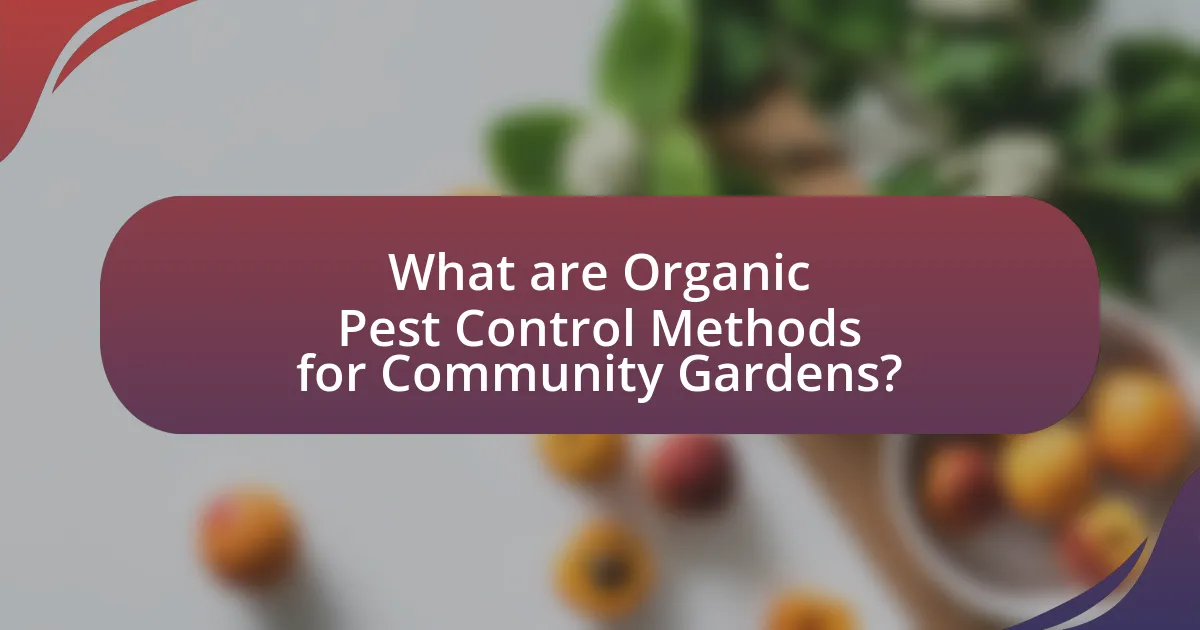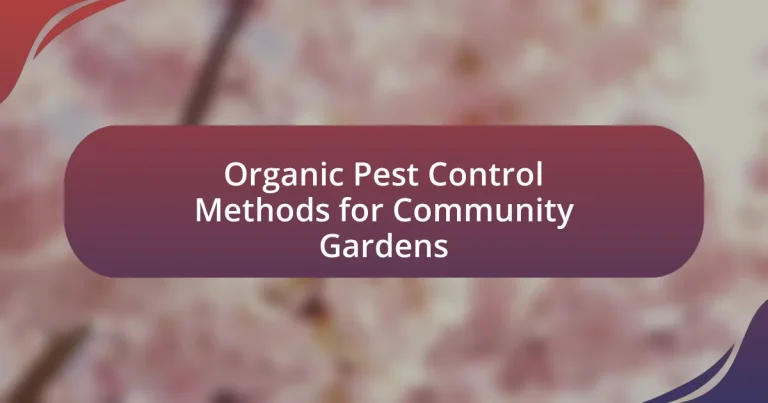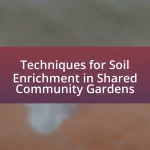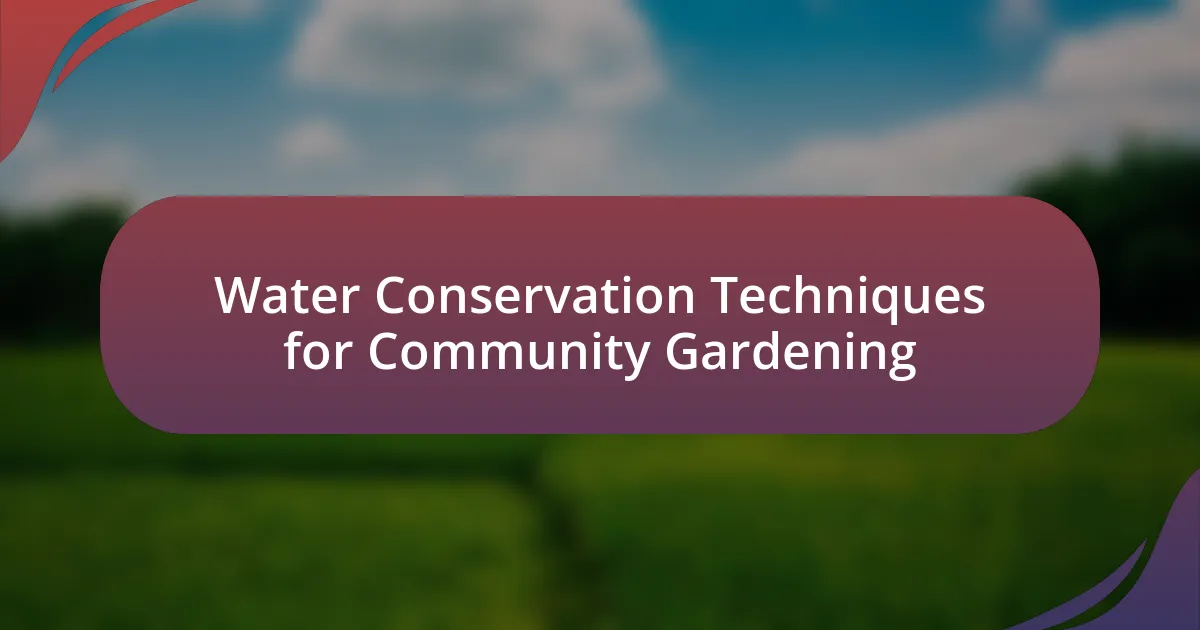Organic pest control methods for community gardens focus on sustainable practices that promote a healthy ecosystem while managing pest populations. Key techniques include the use of beneficial insects, companion planting, natural repellents, and organic pesticides, which collectively enhance biodiversity and soil health. The article outlines the differences between organic and conventional pest control, emphasizing the principles of prevention, monitoring, and intervention. It also addresses common pests found in community gardens, signs of pest damage, and practical tips for effective organic pest management. Additionally, the article highlights the importance of organic methods in fostering environmental sustainability and offers resources for gardeners seeking to implement these practices.

What are Organic Pest Control Methods for Community Gardens?
Organic pest control methods for community gardens include the use of beneficial insects, companion planting, natural repellents, and organic pesticides. Beneficial insects, such as ladybugs and lacewings, help control pest populations by preying on harmful insects. Companion planting involves growing certain plants together to naturally deter pests; for example, marigolds can repel nematodes and aphids. Natural repellents, like neem oil and garlic spray, can be applied to plants to deter pests without harming beneficial organisms. Organic pesticides, derived from natural sources, can be used as a last resort to manage severe infestations while adhering to organic gardening principles. These methods are effective in maintaining a healthy ecosystem within community gardens, promoting biodiversity and sustainability.
How do organic pest control methods differ from conventional methods?
Organic pest control methods differ from conventional methods primarily in their approach to pest management. Organic methods utilize natural substances and biological processes to control pests, focusing on prevention and ecosystem balance, while conventional methods often rely on synthetic chemicals and pesticides that can harm beneficial organisms and the environment. For instance, organic pest control may involve the use of beneficial insects, such as ladybugs, to manage aphid populations, whereas conventional methods might employ chemical insecticides that target a broad range of pests indiscriminately. This distinction highlights the emphasis in organic practices on sustainability and environmental health, aligning with principles outlined by the USDA National Organic Program, which prohibits synthetic pesticides in organic farming.
What are the key principles of organic pest control?
The key principles of organic pest control include prevention, monitoring, and intervention. Prevention involves creating a healthy ecosystem that discourages pests through practices such as crop rotation, companion planting, and maintaining soil health. Monitoring entails regularly checking for pest populations and damage to identify issues early. Intervention focuses on using natural methods to manage pests, such as introducing beneficial insects, using organic pesticides, or employing physical barriers. These principles are supported by research indicating that integrated pest management strategies can effectively reduce pest populations while minimizing environmental impact.
Why is it important to use organic methods in community gardens?
Using organic methods in community gardens is important because they promote environmental sustainability and enhance soil health. Organic practices, such as composting and crop rotation, improve soil structure and fertility, leading to healthier plants. Additionally, organic methods reduce chemical runoff, protecting local waterways and biodiversity. Research indicates that organic farming can increase biodiversity by 30% compared to conventional methods, fostering a more resilient ecosystem. By prioritizing organic methods, community gardens contribute to a healthier environment and promote sustainable agricultural practices.
What types of pests are commonly found in community gardens?
Common pests found in community gardens include aphids, slugs, snails, spider mites, and whiteflies. These pests are prevalent due to the diverse plant species and the close proximity of plants in community gardens, which can create ideal conditions for infestations. For instance, aphids can reproduce rapidly and feed on the sap of various plants, leading to stunted growth and potential plant death. Slugs and snails thrive in moist environments, often damaging seedlings and tender leaves. Spider mites, which are tiny and often go unnoticed until damage is evident, can cause significant harm by sucking the juices from plants. Whiteflies, similar to aphids, can weaken plants and transmit diseases. The presence of these pests highlights the need for effective organic pest control methods in community gardens.
How can gardeners identify common pests in their gardens?
Gardeners can identify common pests in their gardens by observing specific signs of damage on plants, such as holes in leaves, discoloration, or wilting. These symptoms often indicate the presence of pests like aphids, caterpillars, or beetles. Additionally, gardeners can inspect plants closely for the pests themselves, which may be visible on the foliage or stems. Utilizing resources such as pest identification guides or mobile apps can further aid in recognizing the specific types of pests present. Research indicates that early detection of pests can significantly reduce crop damage and improve management strategies, making accurate identification crucial for effective pest control.
What are the signs of pest damage in plants?
Signs of pest damage in plants include visible holes in leaves, discolored or wilting foliage, and sticky residue on leaves. These symptoms indicate that pests such as aphids, caterpillars, or beetles are feeding on the plant. Additionally, the presence of webbing or small insects on the undersides of leaves can further confirm pest infestations. Research shows that early detection of these signs is crucial for effective pest management, as it allows for timely intervention to protect plant health.
What are the benefits of using organic pest control methods?
Using organic pest control methods offers several benefits, including environmental safety, improved biodiversity, and enhanced soil health. These methods minimize chemical residues in the ecosystem, reducing harm to non-target organisms such as beneficial insects, birds, and aquatic life. Research indicates that organic practices can increase the presence of beneficial species, which naturally control pest populations, thereby promoting a balanced ecosystem. Additionally, organic pest control methods often improve soil quality by enhancing microbial activity and nutrient availability, leading to healthier plants and more sustainable gardening practices.
How do organic methods promote biodiversity in community gardens?
Organic methods promote biodiversity in community gardens by enhancing soil health, supporting diverse plant species, and attracting beneficial insects. These methods, such as composting and crop rotation, improve soil structure and nutrient availability, which fosters a variety of plants. A diverse plant community provides habitats and food sources for beneficial insects, such as pollinators and natural pest predators. Research indicates that gardens employing organic practices can host up to 50% more insect species compared to conventional gardens, demonstrating a clear link between organic methods and increased biodiversity.
What impact do organic methods have on soil health?
Organic methods significantly enhance soil health by improving its structure, fertility, and biodiversity. These methods, such as composting and crop rotation, increase organic matter in the soil, which enhances nutrient availability and water retention. Research indicates that organic farming practices can lead to a 30% increase in soil organic carbon compared to conventional methods, promoting healthier microbial communities essential for nutrient cycling. Additionally, organic methods reduce soil erosion and compaction, further contributing to long-term soil vitality.
How can community gardeners implement organic pest control methods?
Community gardeners can implement organic pest control methods by utilizing techniques such as companion planting, introducing beneficial insects, and using natural repellents. Companion planting involves growing specific plants together that can deter pests or attract beneficial insects; for example, marigolds can repel nematodes and aphids. Introducing beneficial insects like ladybugs and lacewings can naturally control pest populations, as these insects feed on harmful pests. Additionally, natural repellents made from ingredients like neem oil or garlic can deter pests without harming the ecosystem. These methods are effective as they promote biodiversity and reduce reliance on synthetic chemicals, aligning with organic gardening principles.
What are some effective organic pest control techniques?
Effective organic pest control techniques include the use of beneficial insects, companion planting, and natural repellents. Beneficial insects, such as ladybugs and lacewings, prey on harmful pests, reducing their populations without chemicals. Companion planting involves growing certain plants together to naturally deter pests; for example, marigolds can repel nematodes and aphids. Natural repellents, like neem oil and diatomaceous earth, disrupt pest life cycles and deter infestations. These methods are supported by research indicating that integrated pest management strategies enhance biodiversity and promote sustainable gardening practices.
How can companion planting help in pest management?
Companion planting can help in pest management by utilizing specific plant combinations that naturally deter pests or attract beneficial insects. For example, planting marigolds alongside vegetables can repel nematodes and aphids due to the compounds they release. Research has shown that certain plants, like basil, can enhance the growth and flavor of tomatoes while also repelling pests such as thrips and whiteflies. This method not only reduces the need for chemical pesticides but also promotes a balanced ecosystem within the garden, leading to healthier plants and improved yields.
What role do beneficial insects play in organic pest control?
Beneficial insects play a crucial role in organic pest control by naturally regulating pest populations and promoting plant health. These insects, such as ladybugs, lacewings, and parasitic wasps, prey on or parasitize harmful pests like aphids and caterpillars, effectively reducing their numbers without the use of synthetic pesticides. Research indicates that the presence of beneficial insects can lead to a significant decrease in pest populations; for example, ladybugs can consume up to 5,000 aphids in their lifetime. This natural predation not only helps maintain ecological balance but also supports sustainable gardening practices in community gardens.
What are the challenges of using organic pest control methods?
The challenges of using organic pest control methods include limited effectiveness against certain pests, variability in results, and the need for frequent applications. Organic methods often rely on natural substances that may not provide the same immediate results as synthetic pesticides, making them less effective against severe infestations. Additionally, the effectiveness of organic solutions can vary based on environmental conditions, pest species, and timing of application, leading to inconsistent outcomes. Frequent applications are often necessary to maintain control, which can be labor-intensive and time-consuming for gardeners.
How can gardeners overcome common obstacles in organic pest management?
Gardeners can overcome common obstacles in organic pest management by implementing integrated pest management (IPM) strategies that combine cultural, biological, and mechanical controls. These strategies include promoting biodiversity through companion planting, using beneficial insects like ladybugs for natural pest control, and employing physical barriers such as row covers to protect crops. Research indicates that IPM can reduce pest populations by up to 90% while minimizing chemical inputs, thus supporting sustainable gardening practices. Additionally, regular monitoring and early intervention can help gardeners identify pest issues before they escalate, ensuring effective management without reliance on synthetic pesticides.
What are the limitations of organic pest control methods?
Organic pest control methods have several limitations, including reduced effectiveness against severe infestations, slower action compared to synthetic pesticides, and potential for inconsistent results. For instance, organic methods often rely on natural predators or biopesticides, which may not eliminate pests as quickly or thoroughly as chemical alternatives. Additionally, the variability in environmental conditions can affect the efficacy of organic solutions, leading to unpredictable outcomes. Research indicates that while organic methods are safer for the environment, they may require more frequent applications and careful monitoring to achieve desired results, making them less practical for large-scale or urgent pest problems.
What resources are available for community gardeners interested in organic pest control?
Community gardeners interested in organic pest control can access a variety of resources, including local cooperative extension services, organic gardening associations, and online platforms like the Organic Materials Review Institute (OMRI). Cooperative extension services provide research-based information tailored to local conditions, while organic gardening associations offer workshops and publications on pest management strategies. OMRI lists approved organic products, ensuring that gardeners use compliant pest control methods. These resources collectively support effective organic pest management in community gardens.
Where can gardeners find educational materials on organic practices?
Gardeners can find educational materials on organic practices through various reputable sources such as the USDA’s National Organic Program, local cooperative extension services, and organizations like the Rodale Institute. These sources provide comprehensive guides, research articles, and workshops focused on organic gardening techniques. For instance, the USDA offers resources that outline organic certification standards and practices, while the Rodale Institute conducts research on organic farming methods and shares findings through publications and online resources.
What local organizations support organic gardening initiatives?
Local organizations that support organic gardening initiatives include community gardens, non-profit environmental groups, and agricultural extension services. For example, the American Community Gardening Association promotes urban gardening and provides resources for organic practices. Additionally, local chapters of organizations like the Sierra Club often engage in initiatives that support sustainable gardening methods. Furthermore, university extension services frequently offer workshops and resources on organic gardening techniques, helping to educate the community on best practices. These organizations collectively contribute to the promotion and support of organic gardening efforts in local areas.
What practical tips can community gardeners follow for successful organic pest control?
Community gardeners can implement several practical tips for successful organic pest control, including the use of companion planting, natural predators, and organic repellents. Companion planting involves growing specific plants together that can deter pests; for example, marigolds can repel nematodes and aphids. Utilizing natural predators, such as ladybugs and lacewings, can effectively reduce pest populations, as these insects feed on aphids and other harmful pests. Additionally, organic repellents like neem oil and insecticidal soap can be applied to plants to deter pests without harming beneficial insects. These methods are supported by research indicating that integrated pest management strategies, which include these practices, can significantly reduce pest issues in organic gardening.





